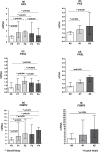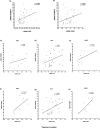Intrahepatic mRNA Expression of FAS, FASL, and FOXP3 Genes Is Associated with the Pathophysiology of Chronic HCV Infection
- PMID: 27243827
- PMCID: PMC4887037
- DOI: 10.1371/journal.pone.0156604
Intrahepatic mRNA Expression of FAS, FASL, and FOXP3 Genes Is Associated with the Pathophysiology of Chronic HCV Infection
Abstract
This study aimed to evaluate the relative mRNA expression of Fas receptor (FAS), Fas ligand (FASL), and forkhead box protein 3 (FOXP3) in liver biopsy specimens obtained from patients with viral and non-viral chronic hepatitis and correlate their expression with the fibrosis stage. A total of 51 liver biopsy specimens obtained from HBV (n = 6), HCV (n = 28), and non-viral hepatic disease (NVHD) (n = 9) patients and from individuals with normal liver histology (n = 8) (control-CT) were analyzed. Quantifications of the target genes were assessed using qPCR, and liver biopsies according to the METAVIR classification. The mRNA expression levels of FAS and FASL were lower in the CT group compared to the groups of patients. The increase in the mRNA expression of FAS and FASL was correlated with higher levels of inflammation and disease progression, followed by a decline in tissues with cirrhosis, and it was also associated with increased levels of alanine aminotransferase (ALT) and aspartate aminotransferase (AST). Higher mRNA expression of FOXP3 was observed in the HCV and NVHD groups, with the peak observed among patients with cirrhosis. The increased FOXP3 mRNA expression was positively correlated with increased FAS and FASL mRNA expression and the AST and ALT levels in all patients.
Conclusions: These results suggest that regardless of the cause, the course of chronic liver disease may be modulated by the analyzed genes and correlated with an increase in regulatory T cells during the liver damage followed by hepatocyte destruction by Fas/FasL system and subsequent non specific lymphocytic infiltrate accumulation.
Conflict of interest statement
Figures







References
-
- Guidotti LG, Chisari FV. Immunobiology and pathogenesis of Viral hepatitis. Annu Rev Pathol. 2006;1: 23–61. - PubMed
-
- Mita E, Hayashi N, Lio S. Role of Fas ligand in apoptosis induced by hepatitis C virus infection. Biochem Biophys Res Commun. 1994;204: 468–474. - PubMed
-
- Jonuleit H, Schmitt E. The regulatory T cell family: distinct subsets and their interrelations. J Immunol. 2003;171: 6323–6327. - PubMed
MeSH terms
Substances
LinkOut - more resources
Full Text Sources
Other Literature Sources
Research Materials
Miscellaneous

